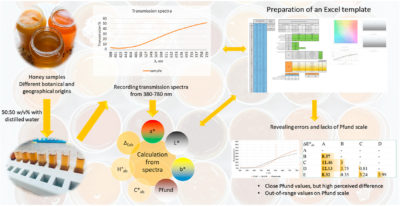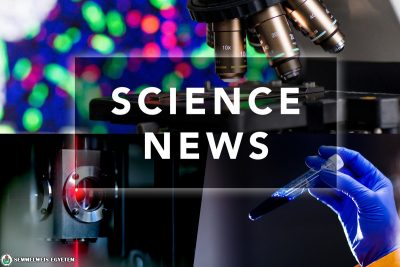Colour of honey: can we trust the Pfund scale? An alternative graphical tool covering the whole visible spectra
 Honey is a popular and versatile nutraceutical product. Its sensory properties, determined by the botanical origin, play a high role in consumers’ decision. Among these, colour is an important, often price-defining property. Colour evaluation of honey can be done by different ways, the most commonly known being the Pfund scale, but Lovibond scale or spectral analysis are used as well. The Pfund method provides a specific evaluation scale for honeys, however, this method is not able to detect slight differences and it also has some deficiencies.
Honey is a popular and versatile nutraceutical product. Its sensory properties, determined by the botanical origin, play a high role in consumers’ decision. Among these, colour is an important, often price-defining property. Colour evaluation of honey can be done by different ways, the most commonly known being the Pfund scale, but Lovibond scale or spectral analysis are used as well. The Pfund method provides a specific evaluation scale for honeys, however, this method is not able to detect slight differences and it also has some deficiencies.
The study’s aim was to provide some examples proving the shortages of the present methodology for determination of honey colour and suggest a solution that could qualify as a possible standardized method. A template providing all the calculations is based on the UV-VIS transmission spectra. The experiment revealed the drawbacks of the Pfund scaling system. We provide an alternative analytical method that can deliver more details and information on honey colour and could overcome the deficiencies of the present protocols – summarized dr. Csilla Benedek, college associate professor of the Department of Dietetics and Nutritional Sciences.
Zsanett Bodor (Hungarian University of Agriculture and Life Sciences, Institute of Food Science and Technology, Department of Physics and Control), Csilla Benedek (Semmelweis University, Faculty of Health Sciences, Department of Dietetics and Nutrition), Agnes Urbin (Budapest University of Technology and Economics, Faculty of Mechanical Engineering, Department of Mechatronics, Optics and Mechanical Engineering Informatics), Daniel Szabo (Hungarian University of Agriculture and Life Sciences, Institute of Food Science and Technology, Department of Postharvest, Supply Chain, Commerce and Sensory Science), Laszlo Sipos (Hungarian University of Agriculture and Life Sciences, Institute of Food Science and Technology, Department of Postharvest, Supply Chain, Commerce and Sensory Science)
LWT (2021), Vol. 149, 111859; https://doi.org/10.1016/j.lwt.2021.111859


